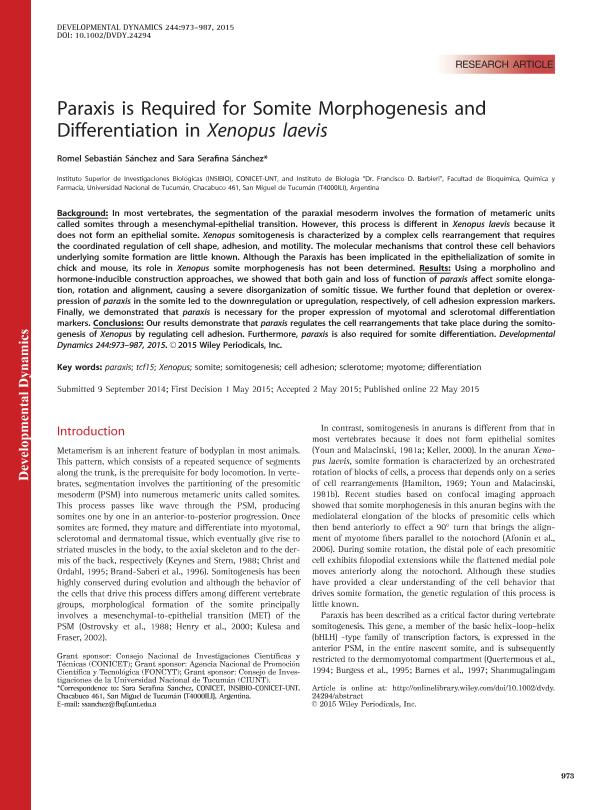Artículo
Paraxis is required for somite morphogenesis and differentiation in Xenopus laevis
Fecha de publicación:
08/2015
Editorial:
Wiley-liss, Div John Wiley & Sons Inc
Revista:
Developmental Dynamics
ISSN:
1058-8388
Idioma:
Inglés
Tipo de recurso:
Artículo publicado
Clasificación temática:
Resumen
Background: In most vertebrates, the segmentation of the paraxial mesoderm involves the formation of metameric unitscalled somites through a mesenchymal-epithelial transition. However, this process is different in Xenopus laevis because itdoes not form an epithelial somite. Xenopus somitogenesis is characterized by a complex cells rearrangement that requiresthe coordinated regulation of cell shape, adhesion, and motility. The molecular mechanisms that control these cell behaviorsunderlying somite formation are little known. Although the Paraxis has been implicated in the epithelialization of somite inchick and mouse, its role in Xenopus somite morphogenesis has not been determined. Results: Using a morpholino andhormone-inducible construction approaches, we showed that both gain and loss of function of paraxis affect somite elongation,rotation and alignment, causing a severe disorganization of somitic tissue. We further found that depletion or overexpressionof paraxis in the somite led to the downregulation or upregulation, respectively, of cell adhesion expression markers.Finally, we demonstrated that paraxis is necessary for the proper expression of myotomal and sclerotomal differentiationmarkers. Conclusions: Our results demonstrate that paraxis regulates the cell rearrangements that take place during the somitogenesisof Xenopus by regulating cell adhesion. Furthermore, paraxis is also required for somite differentiation.
Palabras clave:
Xenopus
,
Somitogenesis
,
Paraxis
Archivos asociados
Licencia
Identificadores
Colecciones
Articulos(INSIBIO)
Articulos de INST.SUP.DE INVEST.BIOLOGICAS
Articulos de INST.SUP.DE INVEST.BIOLOGICAS
Citación
Sanchez, Sara Serafina del V.; Sanchez, Romel Sebastian; Paraxis is required for somite morphogenesis and differentiation in Xenopus laevis; Wiley-liss, Div John Wiley & Sons Inc; Developmental Dynamics; 244; 8; 8-2015; 973-987
Compartir
Altmétricas




